-

新人教版高中英语必修3Unit 2 Morals and virtues教学设计一
(2) students are divided into groups according to the requirements of activity 3. Each student shares a story of personal experience or hearing-witnessing kindness, and then selects the most touching story in the group and shares it with the whole class. Before the students share the story, the teacher can instruct them to use the words and sentence patterns in the box to express. For example, the words in the box can be classified:Time order: first of all, then, after that, later, finally logical relationship :so, however, although, butTeachers can also appropriately add some transitional language to enrich students' expression:Afterwards, afterwards, at last, in the end, eventuallySpatial order: next to, far from, on the left, in front ofOtherwise, nevertheless, as a result, therefore, furthermore, in addition, as well asSummary: in a word, in short, on the whole, to sum up, in briefStep 8 Homework1. Understand the definition of "moral dilemma" and establish a correct moral view;2. Accumulate vocabulary about attitudes and emotions in listening texts and use them to express your own views;3. Complete relevant exercises in the guide plan.1、通过本节内容学习,学生能否理解理解“道德困境”的定义;2、通过本节内容学习,学生能否通过说话人所表达的内容、说话的语气、语调等来判断其态度和情绪;3、通过本节内容学习,学生能否针对具体的道德困境发表自己的看法和见解,能否掌握听力理训练中的听力策略。

新人教版高中英语必修3Unit 3 Diverse Cultures教学设计四
该板块的活动主题是“介绍一个有显著文化特征的地方”( Describe a place with distinctive cultural identity)。该板块通过介绍中国城继续聚焦中国文化。本单元主题图呈现的是旧金山中国城的典型景象, Reading and Thinking部分也提到中国城,为该板块作铺垫。介绍中国城的目的主要是体现中国文化与美国多元文化的关系,它是美国多元文化的重要组成部分。中国城也是海外华人的精神家园和传播中国文化的重要窗口,外国人在中国城能近距离体验中国文化。1. Read the text to understand the cultural characteristics of Chinatown in San Francisco and the relationship between Chinese culture and American multiculturalism;2. Through reading, learn to comb the main information of the article, understand the author's writing purpose and writing characteristics;3. Learn to give a comprehensive, accurate, and organized description of the city or town you live in;Learn to revise and evaluate your writing.Importance:1. Guide the students to read the introduction of Chinatown in San Francisco and grasp its writing characteristics;2. Guide students to introduce their city or town in a comprehensive, accurate and organized way;3. Learn to comb the main information of the article, understand the author's writing purpose, and master the core vocabulary.

新人教版高中英语选修2Unit 2 Learning about Language教学设计
The activity theme of this section is to design various activities around the key words in the first text. Therefore, the activities require students to pay attention to the spelling of words. On the other hand, let students grasp the meaning of words more accurately through sentences and short texts. This kind of teaching design also helps to improve the ability of using English thinking.1. Cultivating students' ability to use word formation to induce and memorize vocabulary, and the ability to use lexical chunks to express meaning.2. Guide the students to think independently and use the correct form of words to complete sentences3. Cultivate students' habit of using lexical chunks to express language completely, guide students to draw words in sentences quickly, pay attention to word collocation, so as to accumulate more authentic expressions4. Instruct students to create sentences with the chunks.1. Enable students to use the language points in the real situation or specific contexts flexibly and appropriately.2. Guiding the Ss to use unit topic words and the sentence patterns in a richer context.Step1: Think of a word that best fits each definition.1. to remember sth2.to accept, admit, or recognize sth or the truth/existence of sth3. the process of changing sth or yourself to suit a new situation4 .to make sb feel less worried or unhappy5. a strong desire to achieve sth

新人教版高中英语选修2Unit 2 Using langauge-Listening教学设计
? B: Absolutely! Getting involved with Chinese cultural activities there definitely helped a lot. I got to practice my Chinese on a daily basis, and I could learn how native Chinese speakers spoke.? A: What do you feel is your biggest achievement?? B: Learning Chinese characters! I have learnt about 1,500 so far. When I first started, I didn't think it was even going to be possible to learn so many, but now I find that I can read signs, menus, and even some easy newspaper articles.? A: What are you most keen on?? B: I've really become keen on learning more about the Chinese culture, in particular Chinese calligraphy. As I have learnt Chinese characters, I have developed a great appreciation for their meaning. I want to explore Chinese characters by learning how to write them in a more beautiful way. ? A: Finally, what do you want to say to anyone interested in learning Chinese?? I have really become keen on learning more about the Chinese culture, in particular Chinese Calligraphy. As I have learnt Chinese character, I have developed a great appreciation for their meaning. I want to explore Chinese characters by learning how to write them in a more beautiful way.? A: Finally, what do you want to say to anyone interested in learning Chinese?? B: I'd say, give it a shot! While some aspects may be difficult, it is quite rewarding and you will be happy that you tried.? A: Thanks for your time. ? B:You're welcome.

新人教版高中英语选修2Unit 4 Reading for writing教学设计
假定你是英国的Jack,打算来中国旅行,请你给你的中国笔友李华写一封信,要点如下:1.你的旅行计划:北京→泰山→杭州;2.征求建议并询问他是否愿意充当你的导游。注意:1.词数80左右(开头和结尾已给出,不计入总词数);2.可以适当增加细节,以使行文连贯。参考词汇:故宫 the Forbidden City;泰山 Mount TaiDear Li Hua,I'm glad to tell you that 'm going to visit China.First,I am planning to visit Beijing,the capitalof China,where I am looking forward to enjoying the Great Wall,the Forbidden City and somebeautiful parks.Then I intend to go to visit Mount Tai in Shandong Province.I've heard that it is one ofthe most famous mountains in China and I can't wait to enjoy the amazing sunrise there.After that,I amalso going to Hangzhou.It is said that it is a beautiful modern city with breathtaking natural sights,among which the West Lake is a well- known tourist attraction.What do you think of my travel plan? Will you act as my guide? Hope to hear from you soon.

新人教版高中英语选修2Unit 4 Using langauge-Listening教学设计
The theme of the listening section is " talking about scenery and culture along a journey."The part is designed to further lead the students to understand Canadian natural geography and social environment, and integrated into the cultural contrast by mentioning the long train journey from Beijing to Moscow routes. On this basis, the part activates students related travel experience, lets the student serial dialogue, guides the student to explore further the pleasure and meaning of the long journey, and Chinese and foreign cultural comparison.The part also provides a framework for the continuation of the dialogue, which is designed to provide a framework for students to successfully complete their oral expressions, and to incorporate an important trading strategy to end the dialogue naturally.1. Help students to understand and master some common English idioms in the context, and experience the expression effect of English idioms.2. Guide the students to understand the identity of different people in the listening context, and finish the dialogue according to their own experience.3. Instruct the students to use appropriate language to express surprise and curiosity about space and place in the dialogue, and master the oral strategy of ending the dialogue naturally.1. Instruct students to grasp the key information and important details of the dialogue.2. Instruct students to conduct a similar talk on the relevant topic.
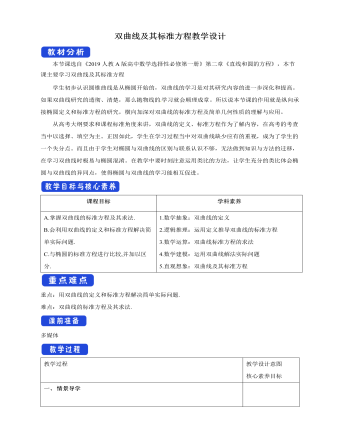
双曲线及其标准方程教学设计人教A版高中数学选择性必修第一册
∵在△EFP中,|EF|=2c,EF上的高为点P的纵坐标,∴S△EFP=4/3c2=12,∴c=3,即P点坐标为(5,4).由两点间的距离公式|PE|=√("(" 5+3")" ^2+4^2 )=4√5,|PF|=√("(" 5"-" 3")" ^2+4^2 )=2√5,∴a=√5.又b2=c2-a2=4,故所求双曲线的方程为x^2/5-y^2/4=1.5.求适合下列条件的双曲线的标准方程.(1)两个焦点的坐标分别是(-5,0),(5,0),双曲线上的点与两焦点的距离之差的绝对值等于8;(2)以椭圆x^2/8+y^2/5=1长轴的端点为焦点,且经过点(3,√10);(3)a=b,经过点(3,-1).解:(1)由双曲线的定义知,2a=8,所以a=4,又知焦点在x轴上,且c=5,所以b2=c2-a2=25-16=9,所以双曲线的标准方程为x^2/16-y^2/9=1.(2)由题意得,双曲线的焦点在x轴上,且c=2√2.设双曲线的标准方程为x^2/a^2 -y^2/b^2 =1(a>0,b>0),则有a2+b2=c2=8,9/a^2 -10/b^2 =1,解得a2=3,b2=5.故所求双曲线的标准方程为x^2/3-y^2/5=1.(3)当焦点在x轴上时,可设双曲线方程为x2-y2=a2,将点(3,-1)代入,得32-(-1)2=a2,所以a2=b2=8.因此,所求的双曲线的标准方程为x^2/8-y^2/8=1.当焦点在y轴上时,可设双曲线方程为y2-x2=a2,将点(3,-1)代入,得(-1)2-32=a2,a2=-8,不可能,所以焦点不可能在y轴上.综上,所求双曲线的标准方程为x^2/8-y^2/8=1.
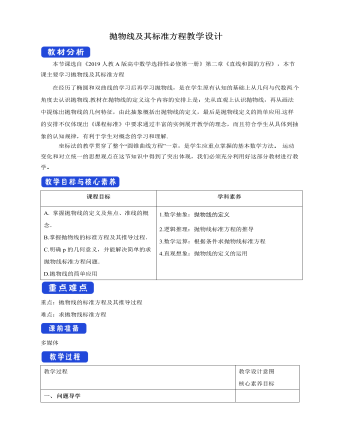
抛物线及其标准方程教学设计人教A版高中数学选择性必修第一册
本节课选自《2019人教A版高中数学选择性必修第一册》第二章《直线和圆的方程》,本节课主要学习抛物线及其标准方程在经历了椭圆和双曲线的学习后再学习抛物线,是在学生原有认知的基础上从几何与代数两 个角度去认识抛物线.教材在抛物线的定义这个内容的安排上是:先从直观上认识抛物线,再从画法中提炼出抛物线的几何特征,由此抽象概括出抛物线的定义,最后是抛物线定义的简单应用.这样的安排不仅体现出《课程标准》中要求通过丰富的实例展开教学的理念,而且符合学生从具体到抽象的认知规律,有利于学生对概念的学习和理解.坐标法的教学贯穿了整个“圆锥曲线方程”一章,是学生应重点掌握的基本数学方法 运动变化和对立统一的思想观点在这节知识中得到了突出体现,我们必须充分利用好这部分教材进行教学

新人教版高中英语必修3Unit 4 Space Exploration-Discovering Useful Structures导学案
【点津】 1.不定式的复合结构作目的状语 ,当不定式或不定式短语有自己的执行者时,要用不定式的复合结构?即在不定式或不定式短语之前加 for +名词或宾格代词?作状语。He opened the door for the children to come in. 他开门让孩子们进来。目的状语从句与不定式的转换 英语中的目的状语从句,还可以变为不定式或不定式短语作状语,从而使句子在结构上得以简化。可分为两种情况: 1?当目的状语从句中的主语与主句中的主语相同时,可以直接简化为不定式或不定式短语作状语。We'll start early in order that/so that we may arrive in time. →We'll start early in order to/so as to arrive in time. 2?当目的状语从句中的主语与主句中的主语不相同时,要用动词不定式的复合结构作状语。I came early in order that you might read my report before the meeting. →I came early in order for you to read my report before the meeting.
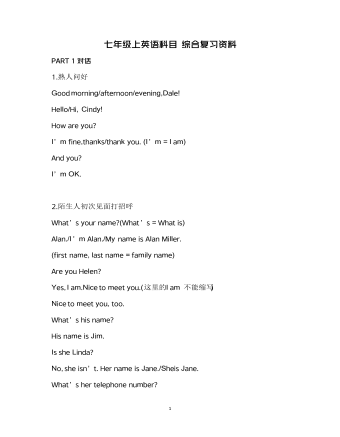
部编版英语七年级上总复习知识点教案
2.陌生人初次见面打招呼What’s your name?(What’s = What is)Alan./I’m Alan./My name is AlanMiller.(first name,last name = family name)Are you Helen?Yes, I am.Niceto meet you.(这里的Iam 不能缩写)Nice to meetyou, too.What’s his name?His name isJim.Is she Linda?

统编版二年级语文上识字3拍手歌教案
《树之歌》是统编版二年级上册第二单元的一篇韵文识字教学课文。儿童熟悉的拍手游戏为活动形式,串起了八种动物的生活场景。儿歌共十个小节,开头与结尾三个小节相互呼应,中间的六个小节分别介绍了羽毛艳丽的孔雀和锦鸡,展翅翱翔的雄鹰,成群的大雁,丛林中的猛虎,啼叫的黄鹂和百灵鸟,憨态可掬的大熊猫。儿歌主要运用拟人手法,使动物形象更加亲切可爱,富有童趣。在教学时,可侧重培养学生的诵读能力,在读中领悟儿歌大意,体会儿歌蕴含的思想感情,使学生受到情感的熏陶。运用多种形象直观的教学手段,创设丰富多彩的教学情景,采用多种方法科学地识记绳生字,提高学生的认字效率和识字兴趣。 1.认识“世、界”等14个生字,会写“歌、写”等10个生字,了解“隹”“鸟”偏旁表义的特点。掌握本课的相关词语。2.正确、流利地朗读儿歌,读出节奏感并背诵。3.感受动物生活的自由、快乐,培养学生保护动物的意识。 1.教学重点:学会本课生字,了解“隹”“鸟”偏旁表义的特点。正确、流利地朗读儿歌,读出节奏感并背诵。2.教学难点:了解“隹、鸟”等偏旁表义的特点。感受动物生活的自由、快乐,培养学生保护动物的意识。 2课时
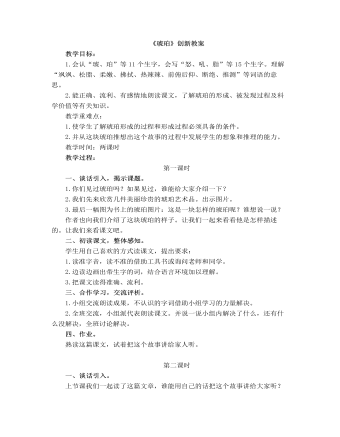
部编人教版四年级下册《琥珀》创新教案
教学重难点:1.使学生了解琥珀形成的过程和形成过程必须具备的条件。2.并从这块琥珀推想出这个故事的过程中发展学生的想象和推理的能力。教学时间:两课时教学过程:第一课时一、谈话引入,揭示课题。1.你们见过琥珀吗?如果见过,谁能给大家介绍一下?2.我们先来欣赏几件美丽珍贵的琥珀艺术品。出示图片。3.最后一幅图为书上的琥珀图片:这是一块怎样的琥珀呢?谁想说一说?作者也向我们介绍了这块琥珀的样子。让我们一起来看看他是怎样描述的。让我们来看课文吧。二、初读课文,整体感知。学生用自己喜欢的方式读课文,提出要求:1.读准字音,读不准的借助工具书或询问老师和同学。2.边读边画出带生字的词,结合语言环境加以理解。3.把课文读得准确、流利。

部编人教版四年级下册《文言文二则》创新教案
三、教学过程(一)导入新课:1.师:同学们,中国是世界上历史最悠久的国家之一,在漫漫的历史长河中,产生了大量的神话传说和历史故事,后来人们把这些神话传说和历史故事加以锤炼,便形成了许多脍炙人口的成语。下面,让我们一起来感受下中华语言文化的精华,背诵下我们积累的成语。)2.学生起头,背诵成语接龙。(在今后的学习中我们还会积累更多的成语,希望同学们继续保持这种学习精神。)3.导入:成语是我国语言文化的精华,它们有的庄重严肃,有的机智幽默,而且大多数的成语背后都有一个生动的故事。今天老师给大家带来个有趣的成语故事,大家想不想看?这个成语故事的名字叫做“铁杵成针”。(板书课题:铁杵成针)不过,老师有个要求,希望同学们能带着这些问题认真去观看。
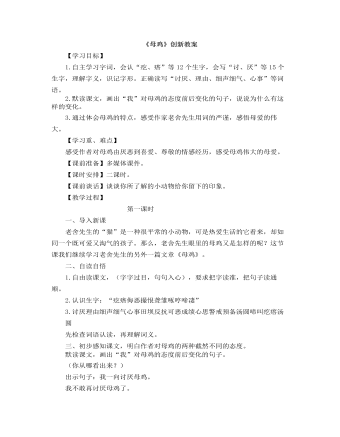
部编人教版四年级下册《母鸡》创新教案
指名学生交流:你选择了是哪个自然段。出示段落(1)不论是在院里,还是在院外,它总是挺着脖儿,表示出世界上并没有可怕的东西。一只鸟儿飞过,或是什么东西响了一声,它立刻警戒起来:歪着头听;挺着身儿预备作战;看看前,看看后,咕咕地警告鸡雏要马上集合到它身边来!你感受到这是一只怎样的母鸡?(勇敢、负责)从文中哪些词语中体会出来。还有同学想说吗?师:从“挺着脖儿、立刻警戒、挺着身儿、咕咕地警告”这些词语我们体会到了勇敢、负责、辛苦的鸡妈妈。现在让我们展开想象的翅膀。想象一下还有哪些情况它立刻警戒起来。(教师口述情境,学生试着说这些词语。)小结:这只母鸡,不论在院里,还是在院外,它总是挺着脖儿。多么负责、勇敢呀!一齐读。

部编人教版四年级下册《天窗》创新教案
【教学设想】1.抓住“小小的天窗是唯一的慰藉。”理解课文内容,了解天窗给乡下小朋友们带来的无尽遐想和无穷快乐。2.作者对天窗的特殊感情,激发学生通过“窗户”看世界的情趣。【教学过程】第一课时(一)激发兴趣,揭示课题1.每栋房子都离不开——窗,可是在近百年前的中国南方农村,窗是怎样的呢?出示课文1—3自然段。(1)读读这三段话,用自己的话说说什么是天窗?人们在屋顶上开天窗的目的是什么?(2)这样一扇简陋的,只能透进些许光亮的天窗却是著名作家茅盾(板书:茅盾)儿时最美好的回忆,于是,他写下了我们今天要学习的散文——天窗。(3)板书课题:天窗(4)齐读课题2.简介茅盾3.天窗为何让茅盾魂牵梦萦?它的魅力在哪里?让我们带着问题走进课文。(二)初读课文,检查预习1.自由读课文,注意生字词的读音,把课文读正确,读流利。2.指名分自然段读课文,读懂每个自然段的意思。3.出示生字、新词,指名认读。
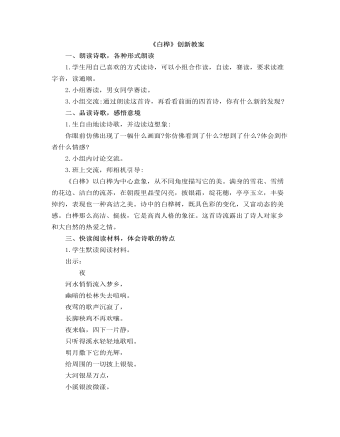
部编人教版四年级下册《白桦》创新教案
一、朗读诗歌,各种形式朗读1.学生用自己喜欢的方式读诗,可以小组合作读,自读,赛读,要求读准字音,读通顺。2.小组赛读,男女同学赛读。3.小组交流:通过朗读这首诗,再看看前面的四首诗,你有什么新的发现?二、品读诗歌,感悟意境1.生自由地读诗歌,并边读边想象:你眼前仿佛出现了一幅什么画面?你仿佛看到了什么?想到了什么?体会到作者什么情感?2.小组内讨论交流。3.班上交流,师相机引导:《白桦》以白桦为中心意象,从不同角度描写它的美。满身的雪花、雪绣的花边、洁白的流苏,在朝霞里晶莹闪亮,披银霜,绽花穗,亭亭玉立,丰姿绰约,表现也一种高洁之美。诗中的白桦树,既具色彩的变化,又富动态的美感。白桦那么高洁、挺拔,它是高尚人格的象征。这首诗流露出了诗人对家乡和大自然的热爱之情。
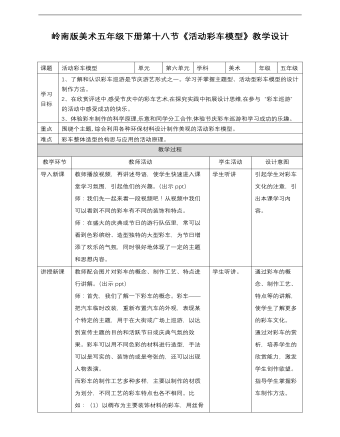
小学美术岭南版五年级下册《第六单元18活动彩车模型》教材教案
1、了解和认识彩车巡游是节庆游艺形式之一。学习并掌握主题型、活动型彩车模型的设计制作方法。 2、在欣赏评述中,感受节庆中的彩车艺术,在探究实践中拓展设计思维,在参与“彩车巡游”的活动中感受成功的快乐。 3、体验彩车制作的科学原理,乐意和同学分工合作,体验节庆彩车巡游和学习成功的乐趣。 围绕个主题,综合利用各种环保材料设计制作美观的活动彩车模型。 彩车整体造型的构思与应用的活动原理。 教师播放视频,再讲述导语,使学生快速进入课堂学习氛围,引起他们的兴趣。(出示ppt) 师:我们先一起来看一段视频吧!从视频中我们可以看到不同的彩车有不同的装饰和特点。 师:在盛大的庆典或节日的游行队伍里,常可以看到色彩缤纷、造型独特的大型彩车,为节日增添了欢乐的气氛,同时很好地体现了一定的主题和思想内容。
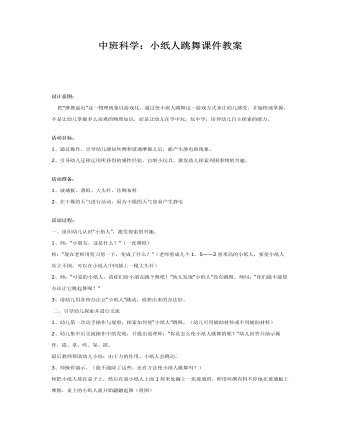
中班科学:小纸人跳舞课件教案
活动目标:1、通过操作,引导幼儿感知丝绸和玻璃摩擦之后,能产生静电的现象。2、引导幼儿迁移运用所获得的感性经验,自制小玩具,激发幼儿探索周围事物的兴趣。活动准备:1、玻璃板、薄纸、大头针、丝绸布料2、在干燥的天气进行活动,因为干燥的天气容易产生静电活动过程:一、组织幼儿认识“小指人”,激发探索的兴趣。1、师:“小朋友,这是什么?”(一张薄纸)师:“现在老师用剪刀剪一下,变成了什么?”(老师剪成几个1.5——2厘米高的小纸人,要使小纸人站立不倒,可以在小纸人中间插上一根大头针)2、师:“可爱的小纸人,请你们给小朋友跳个舞吧!”幼儿发现“小纸人”没有跳舞。师问:“你们能不能想办法让它跳起舞呢?”3、请幼儿用各种办法让“小纸人”跳动,谁想出来的办法好。
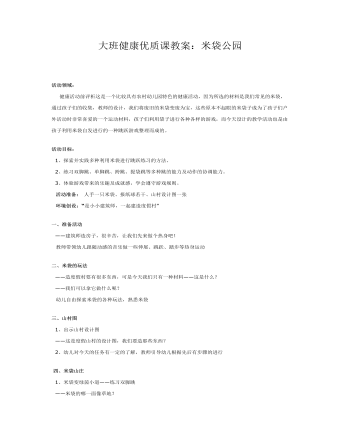
大班健康优质课教案:米袋公园
活动目标: 1、探索并实践多种利用米袋进行跳跃练习的方法。 2、练习双脚跳、单脚跳、跨跳、提袋跳等多种跳的能力及动作的协调能力。 3、体验游戏带来的乐趣及成就感,学会遵守游戏规则。 活动准备: 人手一只米袋、报纸球若干、山村设计图一张 环境创设:“是小小建筑师,一起建造度假村”一、准备活动 ——建筑师造房子,很辛苦,让我们先来做个热身吧! 教师带领幼儿跟随动感的音乐做一些伸展、跳跃、踏步等热身运动二、米袋的玩法 ——造度假村要有很多东西,可是今天我们只有一种材料——这是什么? ——我们可以拿它做什么呢? 幼儿自由探索米袋的各种玩法,熟悉米袋
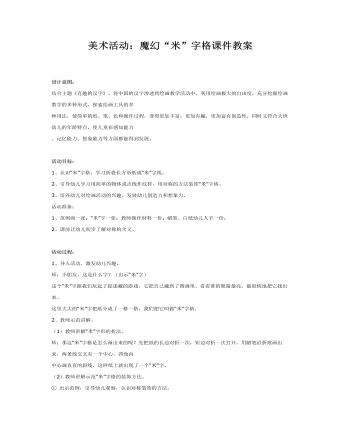
美术活动:魔幻“米”字格课件教案
活动目标:1、认识“米”字格,学习折叠长方形纸成“米”字线。2、引导幼儿学习用简单的物体或点线作纹样,用对称的方法装饰“米”字格。3、培养幼儿对绘画活动的兴趣,发展幼儿创造力和想象力。活动准备:1、范例画一张;“米”字一张;教师操作材料一份;蜡笔、白纸幼儿人手一份;2、课前让幼儿初步了解对称的含义。 活动过程:1、导入活动,激发幼儿兴趣。师:小朋友,这是什么字?(出示“米”字)这个“米”字跟我们玩起了捉迷藏的游戏,它把自己藏到了图画里。看看谁的眼睛最亮,能很快地把它找出来。这里大大的“米”字把纸分成了一格一格,我们把它叫做“米”字格。

